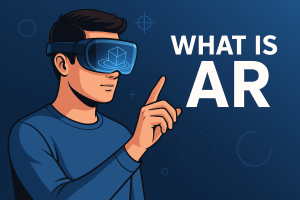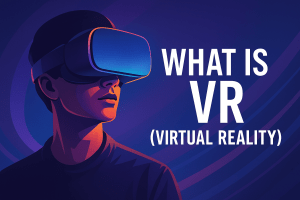When people ask me what is AR, I like to explain that it stands for Augmented Reality, a technology that blends the digital and physical worlds into a single, interactive experience. Unlike Virtual Reality, which transports you into a completely digital environment, AR enhances the real world around you by layering digital elements on top of it. You might not notice it at first, but AR is already everywhere, quietly shaping how we work, learn, shop, and connect.
The beauty of AR is that it does not try to replace reality. Instead, it amplifies it. It gives us the ability to see more, do more, and understand more—without ever leaving our environment.
How Augmented Reality Works
To understand what is AR, it helps to look at how it functions. Augmented Reality relies on a combination of sensors, cameras, and software to detect the user’s surroundings and project virtual objects into them. When you open your phone’s camera and use a filter on Instagram or Snapchat, that is AR in action. The app detects your face and overlays digital elements like sunglasses or animated effects that move naturally with your features.
More advanced AR uses specialized glasses or headsets that display digital information directly into your field of vision. These devices scan the physical world, identify surfaces, and then position virtual elements precisely where they should be. The result is a seamless blend between what you see and what technology adds to it.
For example, if you were wearing AR glasses while walking through a museum, you could look at a painting and instantly see information about the artist, year, and history appear beside it. The real and digital layers merge into one unified experience.
Everyday Examples of AR
When we talk about what is AR, most people immediately think of entertainment, but its reach extends far beyond fun filters and games.
One of the earliest mainstream examples of AR success was Pokémon GO, which turned cities into playgrounds where players caught virtual creatures using their phone’s camera. The game was a cultural phenomenon because it showed how digital interaction could coexist with the real world.
AR has since evolved into a powerful tool for many industries. Retail brands use it to help customers visualize products in their homes before buying. IKEA’s mobile app, for instance, lets you place a virtual sofa in your living room to see how it fits before making a purchase. In education, AR enables students to explore complex subjects through interactive visuals—imagine studying anatomy by seeing a 3D human body projected in front of you.
Healthcare professionals use AR for surgery planning, where doctors can visualize internal organs in real time, enhancing accuracy and safety. In architecture and real estate, clients can walk through virtual versions of their future homes using AR projections. The technology transforms imagination into tangible experience.
The Impact of Augmented Reality on Human Interaction
The rise of AR has also reshaped the way we connect with one another. Social media has embraced it fully. When you use an AR filter on Instagram or TikTok, you are not just enhancing a picture—you are expressing identity through a blend of creativity and technology.
AR bridges communication gaps by making interaction more visual and engaging. Brands use it for storytelling, allowing audiences to experience products rather than simply seeing them. A fashion brand can launch an AR campaign where users try on virtual outfits from their phones. A tourism company can invite people to explore famous landmarks in 3D right from their living rooms.
This interactivity makes communication emotional and memorable. The line between the physical and digital connection becomes beautifully blurred.
The Future of AR in Daily Life
Understanding what is AR also means looking at where it is heading. Experts predict that in the next decade, AR will be as common as smartphones are today. Big tech companies like Apple, Google, and Meta are investing heavily in AR hardware and software.
Imagine walking down a city street wearing lightweight AR glasses that provide real-time navigation, display restaurant reviews beside storefronts, or even translate foreign languages as you read signs. The same technology could revolutionize work environments, letting teams collaborate on shared 3D models during virtual meetings while standing continents apart.
Education will also change dramatically. Instead of reading about the solar system, students will explore it in their classrooms, walking among digital planets while still standing on Earth. This is what makes AR so powerful—it transforms learning from passive observation to active participation.
Even entertainment will evolve. Concerts, theater, and art exhibitions will blend physical and digital elements, offering audiences immersive experiences that engage all senses.
Why Augmented Reality Matters
When I think about what is AR and why it matters, I see it as more than just a technological advancement. It represents a new form of perception. It extends our senses and our ability to interact with the world.
AR makes information intuitive. Instead of reading about something, you experience it. Instead of imagining a concept, you see it come to life before your eyes. It makes learning, shopping, and communication deeply interactive. It also democratizes information by making it accessible in visual, immediate ways that transcend language barriers.
From a marketing perspective, AR changes how businesses reach people. It invites audiences to engage rather than just consume. This shift from passive observation to active participation is the key to modern digital success. When someone experiences a brand through AR, they remember it—not as an ad, but as a moment.
The Human Side of Augmented Reality
There is something profoundly human about AR. Beneath all the coding, sensors, and software lies a desire that has existed for centuries—the desire to make imagination visible. Artists have always tried to extend perception, whether through painting, photography, or film. AR is simply the next step in that evolution.
It lets us bring ideas into the real world in real time. It allows us to see dreams layered over the ordinary. Whether it is a digital butterfly landing on your desk through a phone camera or a holographic tutor helping a student in a remote village, AR embodies creativity and connection.
The challenge, as with any technology, is to use it with purpose. AR has the power to enrich lives, but it can also overwhelm if misused. The key lies in balance—using AR to enhance reality, not escape it.
A Glimpse into Tomorrow
We are at the beginning of a new era where the digital and physical worlds coexist. Understanding what is Augmented Reality gives us insight into how humanity will interact with technology in the coming decades. We are moving from screens to experiences, from devices to environments, from watching to participating.
AR will change how we perceive the world around us, but also how we perceive ourselves within it. It will empower individuals to learn, create, and connect in ways that were once unimaginable. The next generation will grow up not just consuming digital content, but living within it, shaping it, and using it as a natural extension of their reality.
The beauty of augmented reality is that it does not ask us to choose between the physical and digital—it unites them. It reminds us that technology, at its best, is not about replacing what is human, but enhancing what is possible. And as that future unfolds, AR will continue to redefine not only how we see the world, but how we imagine it.









